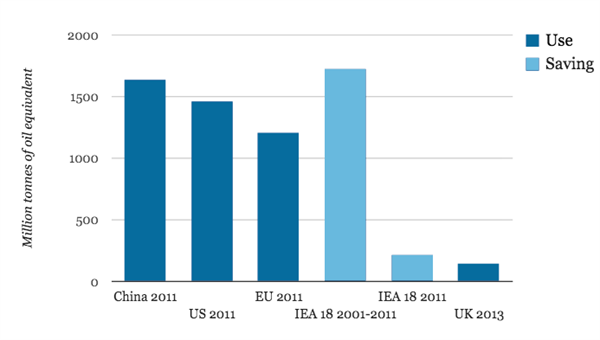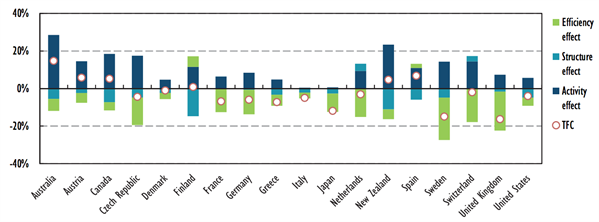Simon Evans
08.10.2014 | 3:30pmEnergy efficiency has saved more energy than is used by the EU, China or the US according to a new report from the International Energy Agency (IEA). It is an “invisible powerhouse” for the global economy, improving energy security, reducing bills and making it easier to avoid dangerous climate change, says IEA executive director Maria van der Hoeven.
The IEA was singing the praises of energy efficiency a month ago but governments seem to be failing to embrace its full potential. Its latest publication takes a more optimistic view of recent progress.
So how much has efficiency achieved since the turn of the century?
Continent-scale energy saving
The most arresting comparison made by the IEA report is that efficiency efforts in the decade to 2011 saved more energy (the large light blue bar on the chart below) than a year’s worth of consumption in the US, China or EU (the dark blue bars).
Those savings were achieved in 18 major countries including France, Germany, the US and the UK. Energy efficiency improvements like better boilers and less thirsty engines mean those countries reduced their combined demand for energy by five per cent in 2011 compared to 2001, the IEA says. In 2011 alone those countries saved around 1.5 times as much energy as used by the UK in 2013 (the small blue bars on the far right, in the chart below).

Source: IEA Energy Efficiency Market Report 2014 and the Digest of UK Energy Statistics 2014; graph by Carbon Brief
The UK comes out as the biggest saver among those 18 nations, having reduced its energy demand by nearly 20 per cent in the decade to 2011. The chart below shows the change in total final energy consumption (TFC) marked with small red circles.
This total is broken down into contributions from growth in the economy (dark blue bars), structural changes such as shifts in types of industrial activity (light blue) and the impact of energy efficiency (green).

Source: IEA Energy Efficiency Market Report 2014
When we looked at why UK energy use has been falling we found, like the IEA, that energy efficiency has played a big part. Given this strong performance it is perhaps surprising that the UK government continues to oppose EU targets for energy saving in 2030.
On the other hand the UK’s leadership status is thought to have slipped more recently as a result of policy reforms. Its Green Deal energy efficiency scheme, for instance, is broadly considered to have been a shambles.
Looking across all 18 nations in the chart above, the IEA says:
“Efficiency has more than countered growing populations and preferences for larger dwellings in reducing absolute energy use among the countries evaluated.”
Global efficiency efforts mean a worldwide figure for energy saved since the turn of the century would be even higher than the continent-scale avoided energy the IEA report focuses on. The global market for energy efficiency was worth between $310 and $360 billion in 2011 and is growing, the IEA says, driving efficiency improvements across all sectors.
Where is all this money going? A separate report published by HSBC breaks things down by sector. This shows that more efficient new homes, insulation and industrial energy efficiency were the top sectors for energy efficiency investment worldwide in 2012 (chart, below).

Source: HSBC Sizing energy efficiency investment report; graph by Carbon Brief
Financial markets have been developing a range of new business models to make efficiency attractive to investors, the IEA says. It found that barriers to investing in efficiency were being removed “almost in real time” as it was in the process of writing its report.
Van der Hoeven says:
“Energy efficiency is moving from a niche interest to an established market segment with increasing interest from institutional lenders and investors.”
There is also a substantial role for public investment in efficiency. The IEA points to Germany’s public investment bank KfW, which spent â?¬16 billion on efficiency in 2013. The UK’s Green Investment Bank spent â?¬181 million in 2012, it says, though its efficiency investments have been in trouble more recently.
The more generous German public investment is often cited as a model of state-backed intervention in the sector. Next year’s UK general election could see energy efficiency rise up the political agenda in this country too.
The IEA’s report says energy efficiency markets have been growing, reaching over $300 billion per year. That’s a good start, but much more will be required. The IEA has previously said investment needs to reach $900 billion a year in 2035 if we are to avoid dangerous climate change.

